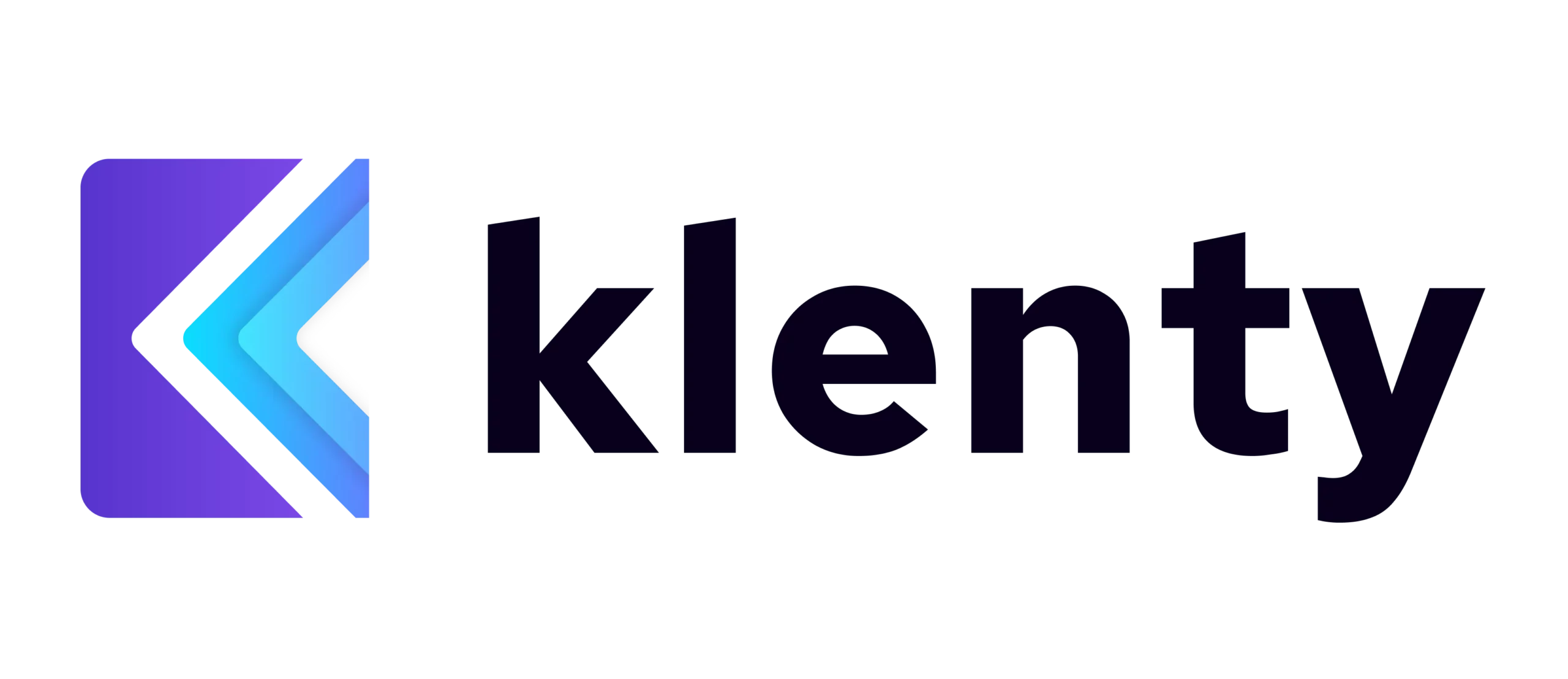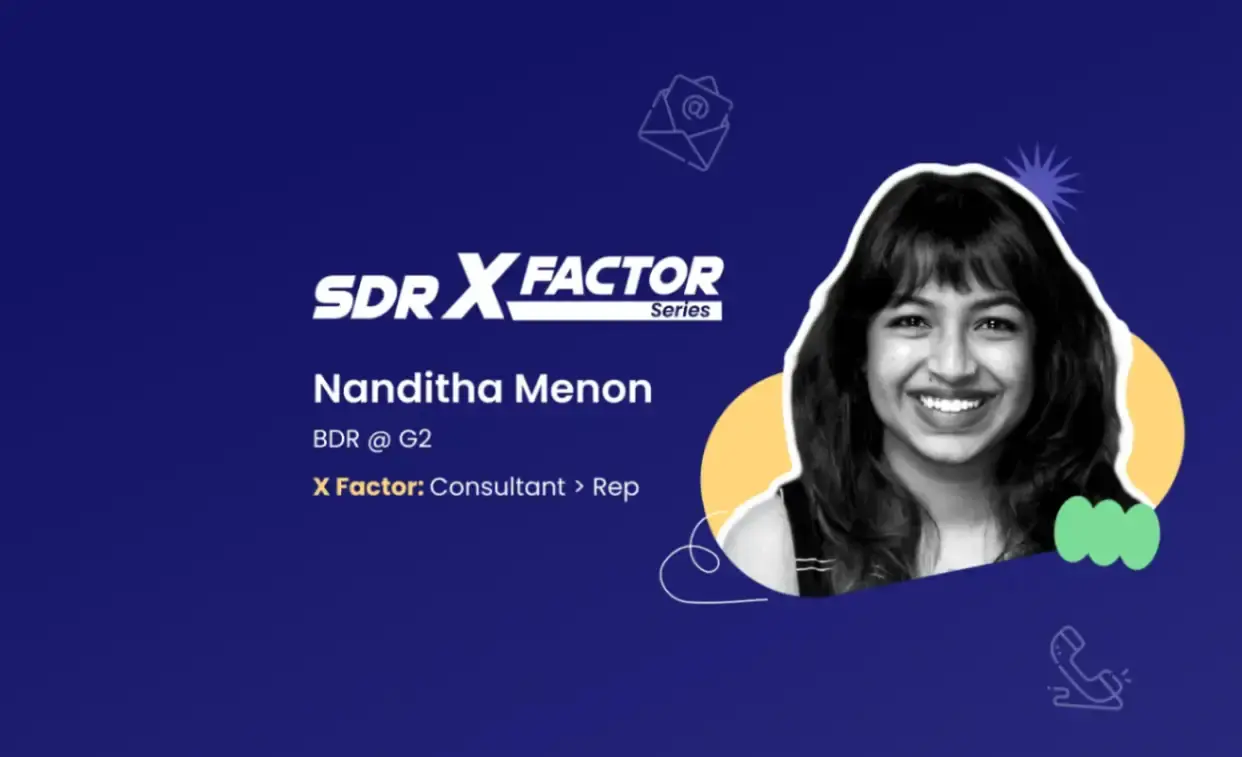The SDR X Factor is a series of long-form stories that aims to reveal what sets top-performing sales reps apart. How do they go about their day? What do their cold calling and cold emailing strategies look like? How are they crushing quota every time? We extract their key strategies, tips and tricks so you can sell better.
For the fourth instalment of this series, we’re joined by Nanditha Menon, a Business Development Representative (BDR) at the B2B software marketplace G2. She works in G2’s Asia-Pacific (APAC) team and her work as an BDR typically involves both inbound and outbound activities, as she carries out both lead qualification and prospecting. She has around 4 years of experience as a salesperson.
We got on a chat with her to know how she cold calls and cold emails, how she reached her current position, and what her philosophy towards sales is.
1) From an Accidental SDR to a Top-Performer

Nanditha landed her first job as a marketing consultant after completing her MBA. At this point, becoming a salesperson was the last thing on her mind. But, life had other plans.
A month into the job, the CEO asked her whether she wanted to try out sales. Willing to try out something new, she agreed and became an SDR. “It was a happy accident. It was never supposed to happen, but luckily, it did,” she grins.
💡After 4 years, Nanditha is now one of the top-performing SDRs at G2’s APAC team. She exceeded her quota for the third quarter in 2022, by hitting 162% of the pipeline creation quota and 125% of the meetings booked quota.
So, what drives her to crush her quotas?
Feeling that adrenaline rush every time after meeting her sales goals is what makes sales an exhilarating job for her. “That’s a rush I get each time when someone books a meeting, when your deals close, when you bring in that huge fat pipeline to the company—that’s what takes me out of the bed every day,” she says. Right now, she’s opting to work from home, which gives her flexibility in terms of getting on Zoom calls with prospects from different time zones, and has a positive impact on her productivity.
i) What Sets Her Apart?
- Acts with a consultant’s mindset to solve prospect’s problems
Being a salesperson, Nanditha doesn’t just sell a solution to the prospect’s problem; her mindset is to actively try to solve their problem.
To do this, she approaches the prospect like a consultant rather than a salesperson. “Being a consultant actually helps you to create that rapport between your prospects and your customers as well,” she asserts, adding, “I love being that person who helps them meet their demand.”
- Creates time blocks for an organized work routine
For maximum efficiency, Nanditha keeps her work routine organized by blocking time for various tasks.
- Her first time block involves clearing her inbox of unwanted emails and following up with prospects.
- Next comes the prospecting timeblock, which involves outreaching mostly through emailing and LinkedIn, and she doesn’t let other tasks like scheduled meetings interfere with this block.
- She reserves the second half of her day for Zoom meetings with prospects. “Towards the end of the day, I wrap up with logging the calls and setting up the meetings for the account managers,” she notes.
2) Why Does Nanditha Prefer Cold Emailing?

For prospecting at G2, Nanditha doesn’t rely on cold calls, but on cold emailing and outreach through LinkedIn.
Her work routine doesn’t usually end at just sending cold emails—she gets on Zoom calls with prospects. “To share the value proposition, we would need to show something on the screen, to show their G2 profile itself. So that way, we rely a lot on Zoom calls,” she says.
Every week, she sends around 400 to 500 emails to meet her monthly target of 1,500 emails per prospect. Apart from regular email outreach through a sales engagement platform, she also sends between 20 and 30 one-off emails to prospects every day.
Here’s a deeper look at the important highlights of Nanditha’s cold emailing process:
i) Spends 15 Minutes for Researching an Account Before Emailing
In her prospecting timeblock, she allocates 15 minutes for researching one account before she gets ready to email. In that 15 minutes, she identifies the PoCs in the account, and collects important information like their email IDs, and learns more about the PoCs by looking at their LinkedIn profiles.
She takes note of their bio and recent activities, so that she can use any relevant information to personalize her emails. “If someone says I love bike riding, or I love traveling, you can even start your opener saying, ‘Hey, I've been traveling these many places, I thought we would share that interest.’ If you're doing research, you might as well show people that you did the research,” she suggests.
ii) Sends 4 Emails per Prospect
In a week, Nanditha would send 4 emails per prospect that’s spaced out roughly over a 7-day period. The first mail on Day 1 will be personalized as per the PoC’s role in the company. She sends the second email on Day 3, which would contain a value proposition.
On Day 5, the third email would go out. This would contain a case study or other sales enablement content. The fourth and final email, which would go out on Day 7, would be a breakup mail. The content of her breakup mail would be on the lines of: “Are you the right person? If you are not the right person, can you redirect us to the right person?”
As far as replies go, Nanditha says she mostly gets replies for the second and third emails.
iii) Does Multithreading Within One Account
One aspect of her cold emailing process Nanditha swears by is multithreading—reaching out to more than one point of contact (PoC) within an account.
In a day, she reaches out to 5 accounts, in which she emails 2 PoCs in the same account. This way, chances are that the 2 different PoCs, who are working in the same company, would know that she is reaching out. “Make that conversation happen. They should talk about your solution. Create that buzz within the organization,” she propounds. So, the chances of booking a meeting would increase significantly, she says.
iv) Keeps Subject Lines Short and Specific
Like most SDRs, Nanditha advocates for short email subject lines—around 4 to 5 words—for better readability on smartphones.
To keep her subject lines specific to the PoCs, she would usually include their first names, company names or their competitor’s company name. “Always talk about them; don't ever talk about what you're offering,” she recommends.
v) Personalizes as per the Prospect’s Role
When it comes to personalizing the email copy, Nanditha changes her approach depending on the role of the PoC she’s reaching out to. “If I'm reaching out to a marketing person, I should be solving a marketing problem. If I'm reaching out to a CEO, I should be solving a larger problem, like about brand visibility,” she elaborates.
vi) Attaches Dashboard Screenshots and Cute Memes 🐕
To keep her emails less text-heavy, Nanditha attaches screenshots of dashboards comparing the G2 profiles of the prospect and their competitor. This would help in presenting the statistics in a better manner and also enables prospects to look at this pitch from a buyer’s perspective, she says.
Also, being a dog person, she would occasionally add cute memes of dogs if she finds out during research that the PoC too is fond of dogs. This has occasionally got her responses that eventually led to booking meetings, she chuckles.
vii) Taps Into the Prospect’s FOMO
Another effective method that she uses during cold emails is tapping into the prospect’s fear of missing out (FOMO). She would craft her email on the lines of, “Hey, this is what your competitor is doing. This is something you're way behind on in the game, and it's something you're missing out on.” She would also attach statistics to support her claim to convince the prospect that they’re indeed lagging behind their competitors.
Psychologists view FOMO as closely linked to the emotional need to belong and fear of social exclusion, which is what makes it an effective tool in the hands of salespeople. Nanditha points out in jest how parents compare their children with the neighbor’s kids to perform better in academics. “Similarly, it’s companies, but they have a kid’s mind,” she says with a grin.
viii) Leverages LinkedIn Activity To Maximize Chances of Booking Meetings
Nanditha actively puts up posts on LinkedIn and leverages that to maximize her chances of getting meetings booked. She posts on LinkedIn at least once in a week with content relevant to her organization, so that she stays at the top of her prospects’ LinkedIn feed.
This helps in reminding them to reply to her emails or LinkedIn messages. “I had a prospect who saw a LinkedIn post of mine, emailed me, and then we got a meeting,” she recalls.
3) How Nanditha Aces the Cold Calling Game

Before G2, Nanditha was running cold calls for 2 years at her first stint as an SDR, where she learned the nitty-gritty of cold calling. At that time, she used to reach out to between 10 and 20 accounts every day through calls.
So, how does Nanditha approach cold calling? Let’s find out:
i) Builds Curiosity in the First Few Moments of the Call
The best approach to ensure that the prospect doesn’t hang up the call immediately after connecting is to build curiosity in their mind in those first few minutes, Nanditha asserts. She accomplishes this by first asking, “Do you have a couple of minutes?” This question would make them curious about what’s in the offing and likely get a yes from them, as opposed to a question like, “Is it a good time to talk?” that could easily get them to say no.
Next, she would frame her opener that directly addresses the prospect’s pain points, something on the lines of, “Hey, I noticed your XYZ company and I want to talk about your {specific domain} solution.”
Her rule of thumb to build curiosity is: “Always put it to them—never say what’s yours.”
ii) Calls Prospects Post-Lunch
Going by her experience, prospects are most likely to attend calls post-lunch on the second half of the day. “In the first half, they’ll be busy with internal meetings,” she notes. Also, SDRs can prioritize getting their outbound prospecting done in the first half of the day, which could also boost productivity, she recommends.
iii) Provides Alternative Options While Handling Objections:
“When they say no, don't feel bad and cut the call. Always try to understand why exactly they say that.” This is how Nanditha sums up her mindset while handling objections. Whatever objects that the prospect might pose during the call, she comes up with alternative options to keep the conversation going in one way or another. Let’s look at how she handles some of the objections:
a) Objection: “This Is Not the Right Time.”
To this, her reply would be quite straightforward: “What is the right time?” or “When do you think we can touch base on this?”
b) Objection: “I’m Not Interested.”
When faced with this objection, she would usually reply: “Do you think I can touch base with you sometime later? Do you think your priorities would change?” Asking for a better time would give the prospect more time to think about and they might likely give an alternative time and date, she says.
c) Objection: “We’re Using Your Competitor’s Tool.”
Knowing the solution inside out and being well aware of its competitive advantages would come in handy for tackling this objection, she points out. “Ask what they're offering and give a proposition as to what you're offering better,” she suggests.
d) Objection: “I’m Not the Right Person.”
Once again, Nanditha has a straightforward response to this: “Who would be the right person? Can you give me the name?” If they provide the details, she follows up with, “Can I take your reference when I'm reaching out to them?”
iv) Mostly Avoids Reaching Gatekeepers
The one suggestion Nanditha is emphatic about is this: Avoid gatekeepers at all costs. “They would not understand the value of your solution,” she says.
Through her research, she tries to get the prospect’s direct contact details to circumvent gatekeepers altogether. As she puts it, “My task is to reach out to the right people, not the wrong people.”
However, in situations where she could reach the prospect only through the gatekeeper, she relentlessly follows up with the gatekeeper till they connect her to the PoC.
v) Builds Rapport by Helping Prospects
The most genuine way to build rapport with prospects is by helping them, Nanditha insists.
Helping all kinds of stakeholders—whether they are a prospect or a customer—is something she feels essential to being a salesperson. “Rapport is by helping them. There is nothing else you can offer them out there. Help them with all the problems in the market,” she emphasizes.
This ties in with her philosophy of salespeople not selling solutions, but acting as consultants who help prospects find effective solutions for their problems.
vi) Nanditha’s Tips From Her Successful Cold Calling Journey:
a) Mention Your Organization’s Name in the Opener:
Mentioning your company’s name at the beginning of the call will help build credibility, and the prospect is more likely to continue the conversation, she notes.
b) Keep Your Value Proposition Brief and Interesting:
You won’t get a lot of time during a cold call to explain your product’s value proposition in detail. So, Nanditha suggests communicating as succinctly as possible the value you’re bringing to their organization. On top of being brief, this should also create interest in the prospect’s mind, so that they agree to get on a meeting with you.
4) Tête-à-Tête With Nanditha

a) One Thing That You Will Not Compromise on When It Comes to Work-Life Balance?
“If you're going on an off, go on an off. I might even sit till 9 p.m. on a Friday night, but I will not pick up my laptop on a Saturday or Sunday.”
b) What Do You Do After Work To Rejuvenate Yourself?
“I will probably go out, watch a movie, or sit with my family.”
c) Top 3 Persons From Whom You Learned the Most About Sales?
“At G2, it’s VP and MD, APAC, Chris Perrine and Director, Sales, Sharath Jagadish. Also, my ex-manager Shashir Shetty.”
d) Best Sales Advice You’ve Ever Received?
“You never lose a deal; it's just not the right time.”
Interviewed and written by: Akileish R

